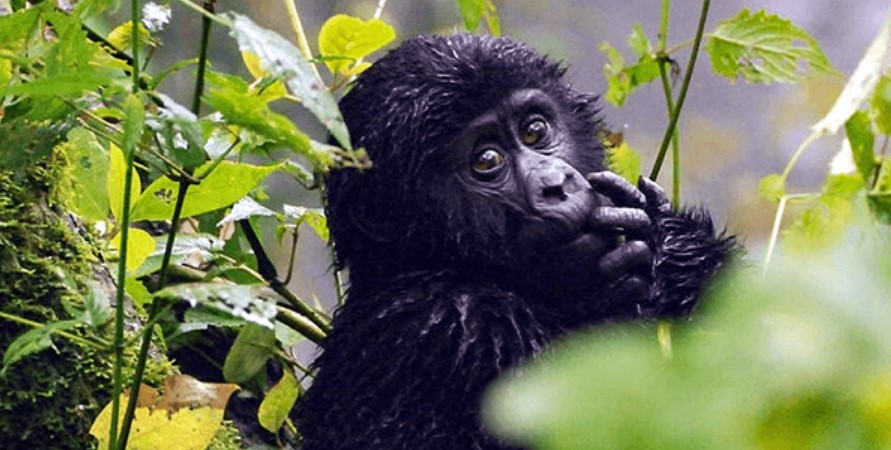Gorilla Reproduction Cycle and Parenting
Gorilla Reproduction Cycle and Parenting, the reproductive cycle of gorillas is remarkably intriguing. Similar to humans, gorillas exhibit a slow reproductive rate, typically birthing a single offspring and nurturing it for several years prior to further births. The sluggish reproductive rate renders gorillas particularly susceptible to population decreases.
Wild female gorillas typically give birth around every four years, without a designated mating season. The gestation period lasts approximately eight and a half months, with births often resulting in a single offspring, but twins may occur seldom.

A newborn gorilla weighs approximately 2 kg and is completely dependent for the initial three months of life, during which it is cradled in its mother’s arms.
The juvenile gorilla rests in the maternal nest at night and traverses on her back during the day. Female gorillas attain reproductive maturity at the age of 10 and subsequently migrate to another group or join a solitary silverback.
Male gorillas attain sexual maturity at the age of 9; however, they do not engage in reproduction until they achieve greater physical maturity as silverbacks, typically between 12 and 15 years of age.
Most male gorillas go from their natal group to assemble females and establish their own familial unit. This may entail aggression, as a young male might intrude upon an established group and attempt to “abduct” females, occasionally resulting in the death of infants.
Occasionally, a male remains in his natal group, becoming the second silverback, mating with several females, and finally usurping leadership upon the aging or death of his father. A female’s initial ovulatory cycle commences at six years of age, succeeded by a two-year phase of adolescent infertility.
The estrous cycle endures for 30–33 days, with less pronounced ovulation indicators than those observed in chimpanzees. The gestation phase endures for 8.5 months. Female mountain gorillas often give birth at the age of 10 and experience interbirth intervals of four years. Male individuals can attain fertility prior to achieving maturity. Gorillas engage in mating throughout the entire year.
Females will pucker their lips and gradually advance towards a male while maintaining eye contact. This serves to prompt the man to copulate with her.
If the male remains unresponsive, she will attempt to capture his attention by extending her reach towards him or striking the ground. In groups with many males, solicitation signifies female preference; yet, females may be compelled to copulate with several males.
Males stimulate copulation by approaching a female, exhibiting displays, making contact, and producing a “train grunt.” Recently, gorillas have been documented participating in face-to-face copulation, a characteristic previously deemed exclusive to humans and bonobos.
Gorilla infants are susceptible and reliant, making their mothers, as primary caretakers, crucial for their survival. Male gorillas do not engage in nurturing the young; however, they contribute to their socialization with other juveniles.
The silverback maintains a predominantly protective connection with the infants in his troop, safeguarding them from intra-group conflict. Infants maintain proximity to their moms for the initial five months, while mothers remain close to the silverback for safety.
Infants nurse at least once per hour and co-sleep with their moms in the same nest. This is another intriguing aspect of the gorilla reproductive cycle.
Infants commence disengagement from their mothers after five months, but for a brief duration each instance. By the age of 12 months, newborns may traverse distances of up to five meters (16 feet) from their mothers. Between 18 and 21 months, the separation between mother and offspring grows, resulting in regular periods of time spent apart.
Nursing frequency is reduced to every two hours.
By 30 months, infants allocate merely half of their time with their mothers. They commence their juvenile phase at three years of age, which persists until they reach six years.
Currently, gorillas are weaned and rest in a distinct nest apart from their mothers. Following the weaning of their young, females commence ovulation and subsequently achieve pregnancy once more. The presence of playmates, especially the silverback, reduces conflicts during weaning between mother and baby.
Wild gorillas have a life expectancy of approximately 35 to 40 years, although captive gorillas can survive into their 50s. The oldest recorded gorilla, a female western gorilla at the Columbus Zoo and Aquarium, reached the age of 60 before her death on January 17, 2017.
During your gorilla safari, you will encounter a diverse variety of ages among the gorillas, including the silverback.
